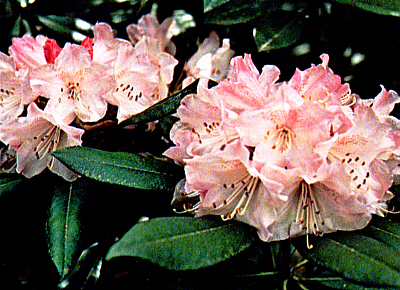QBARS - v28n2 R. balfourianum
R. balfourianum
Taliense Series, ss Adenogynum
Carl Phetteplace, M.D., Eugene, Oregon

|
|
R. balfourianum
Photo by Carl Phetteplace, M.D. |
The plant of my R. balfourianum in my garden was obtained from H. L. Larson of Tacoma about 25 years ago, who had imported it. For a number of years I knew nothing about it except even when small it was attractive. The growth habit was symmetrical and compact. The leathery, deep green leaves were glossy on top and had a buff, fawn or "silky" indumentum on the under surface. It is now a plant six by six feet in dimensions, still perfectly shaped and compact. It began to flower a few years ago, increasingly abundant each season. Last spring after the deadly December '72 cold it was covered with completely undamaged trusses. The florets are pale rose with crimson markings. Their substance may seem a little thin but they stood up in good condition for as long as most others in the garden.
Earlier in my rhododendron experience there were two series that were rarely mentioned except to express lack of interest in them - Ponticum and Taliense. The former because of the strange, mistaken belief that the flowers were of an unattractive magenta color, the latter because they did not flower until very old and were not worth waiting for.
It is interesting how respect for both series has changed with more knowledge. Really the two have much in common. I now grow some members from both groups. In neither was there so much as one leaf or pip damaged by the minus 6° F. freeze of December, 1972. Each series has members with the most attractive foliage in the entire genus. None have a poor plant habit. And where are there more beautiful trusses than has R. yakushimanum , or R. roxieanum , especially var. oreonastes , for example? It is difficult to imagine improving any of them by hybridization. The beauty of such plants in which the over-all habit, the foliage and trusses of flowers are all fused into a composite picture, each feature complementing the other, is a masterpiece of Nature unmatchable by our tinkering with pollen.
Then as a bonus there is little need for concern when a colder winter should come our way.
